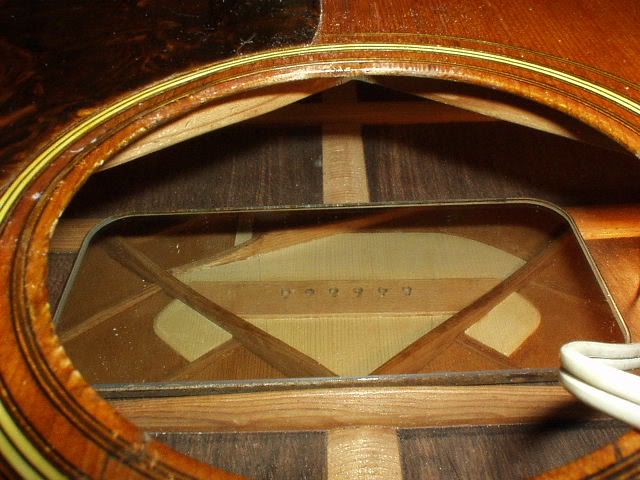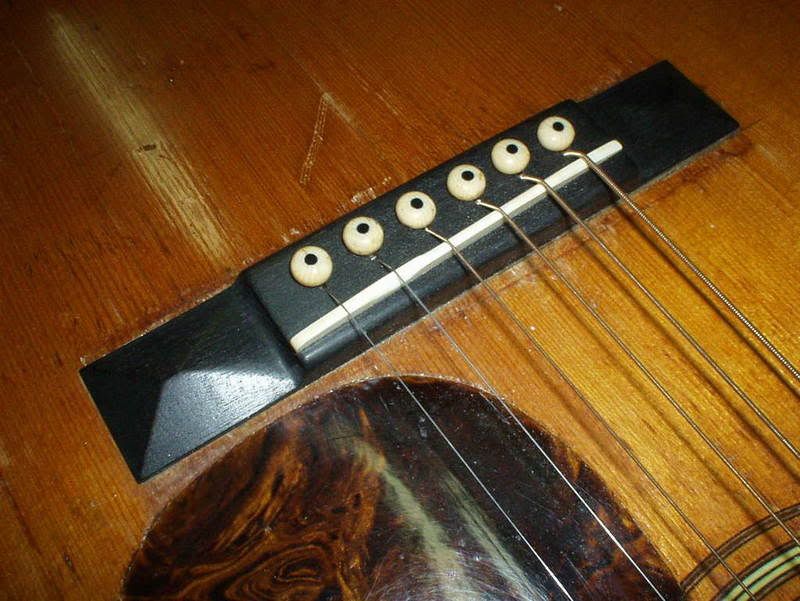
 |
|
#16
|
|||
|
|||
|
An elegant solution, Paul.
The straight endgrain joints on the plug caused me a bit of a "hmmm" moment, but thinking about it further it becomes apparent that the spruce patch takes care of that ... the conformation of the end grain plug joint becomes totally irrelevant. Congrats on staying within the footprint, and maintaining the value of a valuable vintage instrument. Obviously, as you have noted yourself, the critical factor now is to ensure that the bridge never ever lifts again. There is plenty enough of the original footprint for the belly of the bridge to glue onto that this should be no problem. Looking forward to hearing the results demonstrated in due course. |
|
#17
|
|||
|
|||
|
Clever idea with the three part folding patch to fit through the sound hole. I think she'll be good to go.
I must go on record to say I disagree with the Titebond VS Hide glue though... Just had to say it  Of course being a vintage instrument hide is the traditional correct choice but fish glue would have made it a heck of a lot easier 
|
|
#18
|
|||
|
|||
|
Question...
In doing the new patch with the top, didn't you just repeat the exact same thing that the previous guy did, albeit just with a smaller bridge plate? |
|
#19
|
|||
|
|||
|
No.
In the previous repair, spruce was only used in the rectangular hole. The large bridgeplate was used to reinforce the plugged hole. However, this adds unnecessary weight and restricts top vibration. And if the grain is oriented normally (perpendicular to the strings), even a very stiff hardwood bridgeplate will not provide adequate reinforcement. The bridgeplate tends to curl across the grain when subjected to string tension. Spruce is ideal for the repair because it is lightweight, and very stiff along the grain to resist bellying. But spruce is relatively flexible across the grain, allowing vibration. This mimics the original structure of the guitar. I repaired my 1930 OM-28 by a similar method in 1994. The one main difference was the size of the existing hole in the top, which was exactly the same size as the pyramid bridge (1" X 6"). As a result, I also installed spruce patches outside the X-braces.    Recent photo:  The discoloration around the bridge is from the oversize pyramid bridge that was previously installed. If the guitar was better cosmetic condition, I probably would have made more effort to remove the discoloration. No one who has played that guitar has detected any problem with the sound. Notables include Tony Rice, Robert Bowlin and Larry Wexer. That is in stark contrast to guitars with oversize bridges and/or bridgeplates, which almost always take a back seat in regards to sound or resale value. This is the repair method I prefer because it preserves the sound and structure of the guitar, using the original size bridge and bridgeplate. Since that repair (and a similar repair of my 1927 000-18), I have repeated it many, many times on customer guitars with unqualified success. Last edited by John Arnold; 07-29-2016 at 09:01 AM. |
|
#20
|
|||
|
|||
|
Quote:
__________________
Andersonville Tennessee Clinch River Instruments, White Oak O, 13 fret Nick Lucas, 1937 spec D-18 Martin 000-28 EC Gibson Les Paul Gibson 335 Dot Bunch of Strats Fender B-Bender Tele Last edited by clinchriver; 08-05-2016 at 04:26 AM. |
|
#21
|
|||
|
|||
|
John, thats an interesting method. However I don't see how having the filler piece inlaid as end gran to end grain will work. End grain does not glue well (if at all) and I'm thinking a scarf joint would be more stable since it would allow for more long grain to be available for the gluing.
|
|
#22
|
|||
|
|||
|
Quote:
Steve
__________________
Cole Clark Fat Lady Gretsch Electromatic Martin CEO7 Maton Messiah Taylor 814CE |
|
#23
|
|||
|
|||
|
I've done it this way a couple times myself though after looking at this one and John's repair I like the way they did a few things differently. Anyway the end grain on end grain is moot. It does indeed not have any structural integrity but what you are doing is essentially building a 'clamp' of sorts. The inlayed patch is just there to level the surface for the bridge foot print but it's really held in there by the underlying spruce patch, bridge plate and the bridge itself.
If I understand John's repair correctly by the image it looks like the spruce patch is actually one entire unit? So that you took a larger piece of spruce and routed it down to fit the hole? That seems like the best of both worlds but either way will work. I have yet to see the ones I did years agho like that come back anyway. |
|
#24
|
|||
|
|||
|
What a beautiful project. Thanks for all the images and descriptions!
|
|
#25
|
|||
|
|||
|
Quote:
Quote:
Quote:
|
|
#26
|
|||
|
|||
|
I would love to see, from the people blithely advocating a scarf joint on this repair, a step by step, blow by blow account of exactly how they would have gone about it.
And a diagram as well. |
|
#27
|
|||
|
|||
|
Quote:
BTW, you don't actually attract answers by insulting the people from whom you are asking for them. Scarfers like to think they are more intrepid than blithe. {;-> http://frets.com/FretsPages/Luthier/...restore01.html
__________________
"Still a man hears what he wants to hear, and disregards the rest." --Paul Simon Last edited by Howard Klepper; 08-05-2016 at 10:58 AM. |
|
#28
|
|||
|
|||
|
I think we can forego the pistols at dawn, Howard ...
 ... it is surely possible to be simultaneously blithe and intrepid. ... it is surely possible to be simultaneously blithe and intrepid.I had thought of adding "without massive invasive surgery" after the first sentence of my post above. I honestly cannot conceive of any owner, presented with the two options, acquiescing to the process to which you link, compared to the process which was actually carried out on this OM, especially in view of the testimony of the highly respected guitar players mentioned above that they could not detect any diminution in sound in an instrument with a similar repair. |
|
#29
|
|||
|
|||
|
Having the back off facilitates the repair, but it can be done through the soundhole. And the patch can be made trapezoidal so it fits within the braces if the bridge is further forward (or the braces R&R'd, which is a bunch more work).
When multiple methods can produce satisfactory results, which is often the case with guitar repair, people may differ in their judgment about whether it is worth doing extra work to create greater structural integrity.
__________________
"Still a man hears what he wants to hear, and disregards the rest." --Paul Simon |
|
#30
|
||||
|
||||
|
Just in case you're feeling lonely, Howard, or possibly missed my early post in this thread, I am firmly in your camp . . . so far. I am not surprised tha the band-aid repair can work well enough that the guitar remains viable, or even superior to most, but I have to doubt that added mass does not alter it from the original result. And since I consider weight to be burden, particularly in such a case as this, I come down in favor of the less complex and and probably no more technically challenging scarf solution.
Observation: The router/jig as well as abrasives have become much more prevalent in today's version of lutherie than the truly sharp chisel and the steel cabinet scraper, which truth (IMO) seems to be at play here. |
 |
|
| Tags |
| dream guitars, martin guitars, pre-war martin, repair |
|
|